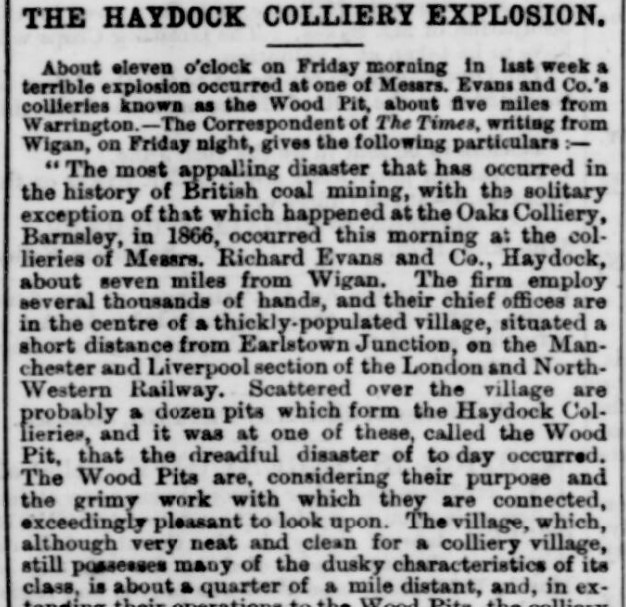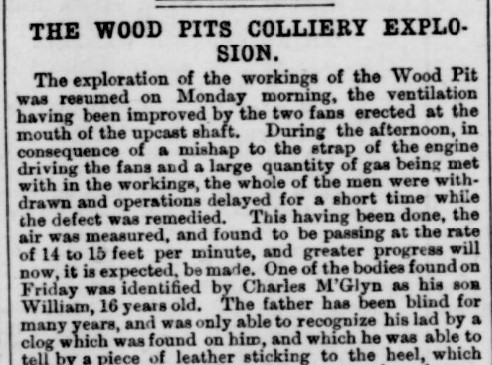This week we have added 107,280 brand new pages to our collection, as one brand new title, the Selby Times, joins our Archive. Meanwhile, from Bayswater to Bradford, from Devizes to Dundee, we’ve updated a range of our existing titles, with significant updates joining our Scottish newspapers, including the Edinburgh Evening News.
So read on to find out about our new and updated titles of the week, and also to learn about the Wood Pit colliery explosion, a tragic mining accident that occurred in June 1878 and claimed many lives.
Register now and explore the Archive
We’re delighted to welcome our solo new title to The Archive this week, which is the Selby Times. The Selby Times was founded in the Yorkshire market town of Selby, which was historically a part of the West Riding of Yorkshire, and now sits within North Yorkshire, as the Selby Times and Howdenshire and Goole Advertiser, in January 1860. This politically neutral weekly newspaper appeared initially every Friday at the cost of one pence, and was printed and published by William B. Bellerby from the Crescent, Selby.
Indeed, in the nineteenth century the Selby Times was the ‘only paper printed in’ the ‘important town’ of Selby, and it was ‘its recognised organ.’ According to an advert for the newspaper in the late 1880s, ‘the circulation of the Times…still continues to increase in Selby and the surrounding district, and exceeds in its own area that of nearly all the other Yorkshire weekly papers combined.’
A ‘first-class advertising medium,’ the Selby Times circulated in ‘Selby, South Milford, Milford Junction, Sherburn, Goole, Howden, Carlton, Drax, Church Fenton, Cawood, Bubwith, Market Weighton, and the neighbourhood.’
Moving to a Saturday publication pattern, the Selby Times filled four pages, each page consisting of six columns. It printed a mixture of national and international news, with a section devoted to ‘Miscellaneous Intelligence’ from ‘Home, Foreign and Colonial’ sources, as well as a ‘British and Foreign Epitome of News.’ Meanwhile, the publication featured news from the local area, reporting on the Selby Agricultural Show and the Bubwith Foal Show, whilst also publishing notices of births, marriages and deaths.
The Selby Times is still running to this day, and it appears every Thursday, having merged with the Selby Post to become the Selby Times & Post. It is the sister paper to the Goole Times, and it celebrated its 150th anniversary in 2010.
Another newspaper to celebrate its 150th anniversary, although in recent weeks, is the Edinburgh Evening News, to which we have added over 17,000 brand new pages from the years 1936 to 1937, and 1961 to 1962. This week also sees further pages joining a selection of our other Scottish newspaper titles, with updates to the Dundee Courier and the Oban Times and Argyllshire Advertiser.
The Wood Pit Colliery Explosion – June 1878
On 7 June 1878 there was a terrible explosion at the Wood Pit colliery at Haydock, near Warrington, which was historically a part of Lancashire. This week’s new newspaper, the Selby Times, printed an extensive account of the accident a week later on 14 June 1878, labelling it a ‘most appalling disaster.’
The Selby Times outlined how the Wood Pit colliery was owned by Richard Evans and Co., who employed ‘several thousands of hands’ and ran ‘probably about a dozen pits which formed the Haydock Collieries.’ It was ‘one of these, called the Wood Pit, that the dreadful disaster of to day occurred.’ John Turton was the ‘certificated manager’ in charge of the pit, and it was he who raised the alarm that something was wrong.
The Selby Times describes how:
Shortly after eleven o’clock Mr. Turton came up the shaft, after inspecting the workings, and was walking away from the pit brow, when he was startled by dust coming up both the downcast and upcast shafts. Fearing that some disaster had occurred, he immediately dispatched messengers for help, and, without delay, himself gave the signal to the engine-man and was lowered into the pit.
An underground gas explosion had taken place, and soon the rescue work began. This was hindered, however, due to the ‘terrible force of the blast,’ which meant that ‘the roadways were greatly damaged, and only slow progress could be made into the workings, notwithstanding that nearly 100 men were employed on the work.’
It was a hellish task, the Selby Times recounting how:
The roads were blocked with large falls of roof, tubs were scattered and blown to pieces, and horses lay dead across the roads. As the exploring parties proceeded, the bodies of the killed were found, dreadfully disfigured. They were placed at one side of the road and ticketed as found but it was considered unadvisable to remove them to the pit-eye and thence to the surface.
Soon news of the dreadful accident began to spread, and the inhabitants of Haydock began ‘to throng the approaches to the pit.’ Survivors’ accounts, too, began to emerge, including that of George Whiby. George had been ‘working in the same seam at the time of the explosion, but on the opposite side of the pit, in the new workings.’ The Selby Times described how:
…shortly after eleven he heard the explosion of the gas and knew at once the pit had fired. The noise almost stunned him, but he made immediately for the surface, going along the road he used regularly night and morning. The afterdamp was upon him before he got ten yards from the face of the coal, and he was struck down three times. He turned to go through the shunt, and at last managed to reach the pit eye. He lost his way for half an hour, and when he arrived at the shaft he fell down insensible.
The awful extent of the explosion soon became clear. The Selby Times related how fifty lamps belonging to the workers of the pit had been returned, ‘leaving 201 to be accounted for.’ The difficulties in working out the number of those who had lost their lives were hampered by many of those involved being ‘drawers,’ who were sub-contractors and not directly employed by the mining company. Consequently, no record of them were ‘kept at the pay offices.’
In the nearby village of Earlston, meanwhile, it was ‘said that in one street…there is not a single house but has lost one or two members of the family.’ Messages of sympathy were received from the Home Secretary and Queen Victoria, the latter of whom ‘expressed her deep sympathy with the sufferers by the calamity.’

A week later on 21 June 1878 the Selby Times reported on the progress of the exploration of Wood Pit. Further victims had been found, including the body of 16-year-old William McGlyn, who was identified by his blind father Charles. Charles, who also worked in a coal pit, was only able to ‘recognise his lad by a clog which was found on him, and which he was able to tell by a piece of leather sticking to the heel, which the father himself had nailed there several weeks previously.’
Meanwhile, Mary Redford was able to identify her son John. Thankfully, her husband and her eldest son survived the blast. It was reported too by the newspaper that ‘in one family a husband, two sons-in-law, and an uncle have all been killed.’
It was a tragedy that shook the community, with ramifications that would echo down the decades. It was ultimately reported that 189 men and boys had lost their lives, and a memorial to the dead was subsequently erected at St James the Great church in Haydock. Another memorial was raised over 130 years later, in 2009, closer to the site of the disaster.
Find out more about the Wood Pit explosion, industrial history, and much more besides, in the pages of our Archive today.
New Titles
| Title | Years Added |
| Selby Times | 1869, 1871-1896, 1899-1911, 1913-1916 |
Updated Titles
This week we have updated fifteen of our existing titles.
You can learn more about each of the titles we add to every week by clicking on their names. On each paper’s title page, you can read a FREE sample issue, learn more about our current holdings, and our plans for digitisation.
| Title | Years Added |
| Armley and Wortley News | 1892-1896, 1899 |
| Bayswater Chronicle | 1939 |
| Bingley Chronicle | 1889-1894, 1896, 1898-1899 |
| Bradford Daily Telegraph | 1913, 1916 |
| Devizes and Wilts Advertiser | 1883 |
| Downham Market Gazette | 1892 |
| Dundee Courier | 1993, 1995 |
| Eastern Post | 1923 |
| Edinburgh Evening News | 1936-1937, 1961-1962 |
| Essex & Herts Mercury | 1837, 1841 |
| Hinckley Echo | 1920 |
| Loftus Advertiser | 1902 |
| Oban Times and Argyllshire Advertiser | 1874, 1917 |
| Sheerness Guardian and East Kent Advertiser | 1911, 1929 |
| South Bank Express | 1910-1911, 1913 |
You can keep up to date with all the latest additions by visiting the recently added page. You can even look ahead to see what we’re going to add tomorrow.










